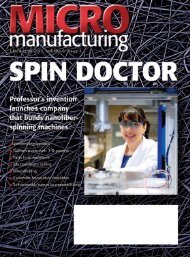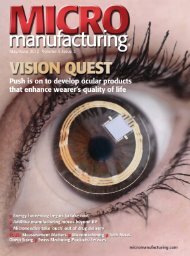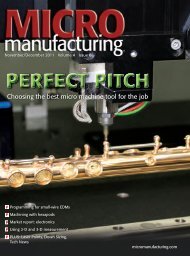Click here to view as PDF - MICROmanufacturing
Click here to view as PDF - MICROmanufacturing
Click here to view as PDF - MICROmanufacturing
You also want an ePaper? Increase the reach of your titles
YUMPU automatically turns print PDFs into web optimized ePapers that Google loves.
Machines for micromolding<br />
In micromolding, material is injected<br />
in<strong>to</strong> molds by machines with extremely<br />
compact injection units. One such machine,<br />
known <strong>as</strong> the Babypl<strong>as</strong>t, injects<br />
material volumes <strong>as</strong> small <strong>as</strong> 4cm 3 . Th e<br />
purpose of the small injection unit is <strong>to</strong><br />
reduce material residence time, during<br />
which pl<strong>as</strong>tics can degrade due <strong>to</strong> exposure<br />
<strong>to</strong> heat.<br />
Some high-end engineered materials<br />
are more sensitive <strong>to</strong> heat than more<br />
common pl<strong>as</strong>tics, according <strong>to</strong> Tony<br />
Brusca, president of Alba Enterprises<br />
Inc., a machine distribu<strong>to</strong>r in Rancho Cucamonga,<br />
Calif., that sells the Babypl<strong>as</strong>t.<br />
In some c<strong>as</strong>es, however, microparts require<br />
complex molds that are <strong>to</strong>o large <strong>to</strong><br />
fit in<strong>to</strong> small machines like the Babypl<strong>as</strong>t.<br />
Microparts “tend <strong>to</strong> be intricate,” said Paul<br />
Ziegenhorn, president of Matrix Tooling<br />
Inc./Matrix Pl<strong>as</strong>tic Products, a full-line<br />
injection molding company in Wood<br />
Dale, Ill. “So even though a part might<br />
be small, the mold might have <strong>to</strong> be [relatively]<br />
large <strong>to</strong> hold all the mechanical<br />
features, such <strong>as</strong> slides and lifters, needed<br />
<strong>to</strong> make the details on the part.”<br />
T<strong>here</strong>fore, Ziegenhorn continued, “we<br />
run some very small parts on 22-<strong>to</strong>n, electric-injection<br />
molding machines. These<br />
machines have larger barrels, and you<br />
have a residence-time issue if you have an<br />
oversized barrel. So we have <strong>to</strong> manage<br />
the process <strong>to</strong> get the material through<br />
the barrel <strong>as</strong> quickly <strong>as</strong> we can before it<br />
starts <strong>to</strong> degrade.”<br />
Occ<strong>as</strong>ionally, the result is<br />
material w<strong>as</strong>te, which can be<br />
costly. “Some of the<br />
implantable products<br />
we mold are made of<br />
resins that cost well<br />
over $3,000 a pound.<br />
And if we produce<br />
any w<strong>as</strong>te or scrap,<br />
it can’t be reused,”<br />
Ziegenhorn explained.<br />
“So we’re trying <strong>to</strong> balance<br />
the need of the<br />
cus<strong>to</strong>mer—which is <strong>to</strong><br />
spend the le<strong>as</strong>t amount possible on the<br />
resin—with the fact that a particular part<br />
requires a mold that is a certain size.”<br />
F<strong>as</strong>ter flow<br />
Molded microparts tend <strong>to</strong> have thinner<br />
walls than their larger counterparts.<br />
In molding, thinner walls result in f<strong>as</strong>ter<br />
cooling and solidifying of the pl<strong>as</strong>tic.<br />
T<strong>here</strong>fore, “the thinner the wall, the<br />
f<strong>as</strong>ter you have <strong>to</strong> fill the mold,” noted<br />
Carol Barry, a professor in the department<br />
of pl<strong>as</strong>tics engineering at the University<br />
of M<strong>as</strong>sachusetts-Lowell. According <strong>to</strong><br />
Barry, micromolds must be filled in no<br />
more than 0.2 seconds, compared <strong>to</strong> approximately<br />
1 <strong>to</strong> 5 seconds taken <strong>to</strong> fill<br />
conventional molds.<br />
Among other things, f<strong>as</strong>ter injection<br />
means higher pressures in micromolding<br />
machines. While a conventional machine<br />
Matrix Tooling<br />
A device used in coronary artery byp<strong>as</strong>s surgery that fires staples, eliminating the need <strong>to</strong><br />
hand suture blood vessels. The device is made from micromolded components, including<br />
small drivers (one is pictured on the dime) that push and form the staples <strong>as</strong> the device is<br />
activated. The unit shown is about 0.750" long. The small drivers me<strong>as</strong>ure about 0.020"<br />
across.<br />
Alba Enterprises<br />
A Babypl<strong>as</strong>t micromolding machine.<br />
might have a maximum injection pressure<br />
of approximately 20,000 <strong>to</strong> 25,000<br />
psi, micromolding machines can go up <strong>to</strong><br />
35,000 psi, according <strong>to</strong> Barry. She added<br />
that these higher pressures make the machines<br />
more expensive <strong>to</strong> buy than conventional<br />
systems.<br />
In addition <strong>to</strong> pressure, temperature<br />
can have a major impact on micromolding.<br />
In conventional molding, “you run<br />
(the mold) at the coldest temperatures<br />
you can get away with, because cooling<br />
is what dictates the cycle time,” Barry<br />
explained. In micromolding, however,<br />
higher mold temperatures can decre<strong>as</strong>e<br />
material viscosity and, t<strong>here</strong>by, improve<br />
fl o w.<br />
On the downside, those who crank up<br />
mold temperatures <strong>to</strong> improve material<br />
flow risk degrading the material. Types<br />
of degradation that can be caused<br />
by high mold temperatures include<br />
diminished mechanical<br />
properties and burned<br />
spots on parts, according<br />
<strong>to</strong> Ron Peterson, vice<br />
president of Micromold<br />
Inc., Riverside, Calif.<br />
To prevent such unsatisfac<strong>to</strong>ry<br />
results, micromolders<br />
improve material<br />
flow by molding parts at the highest<br />
temperature that does not cause the<br />
pl<strong>as</strong>tic <strong>to</strong> degrade. Higher mold temperatures<br />
can be achieved by techniques such<br />
<strong>as</strong> infrared heating of the mold surface<br />
and blowing hot air on the mold, according<br />
<strong>to</strong> Barry.<br />
But Barry also pointed out an important<br />
negative consequence of using such<br />
micromanufacturing.com | 31















